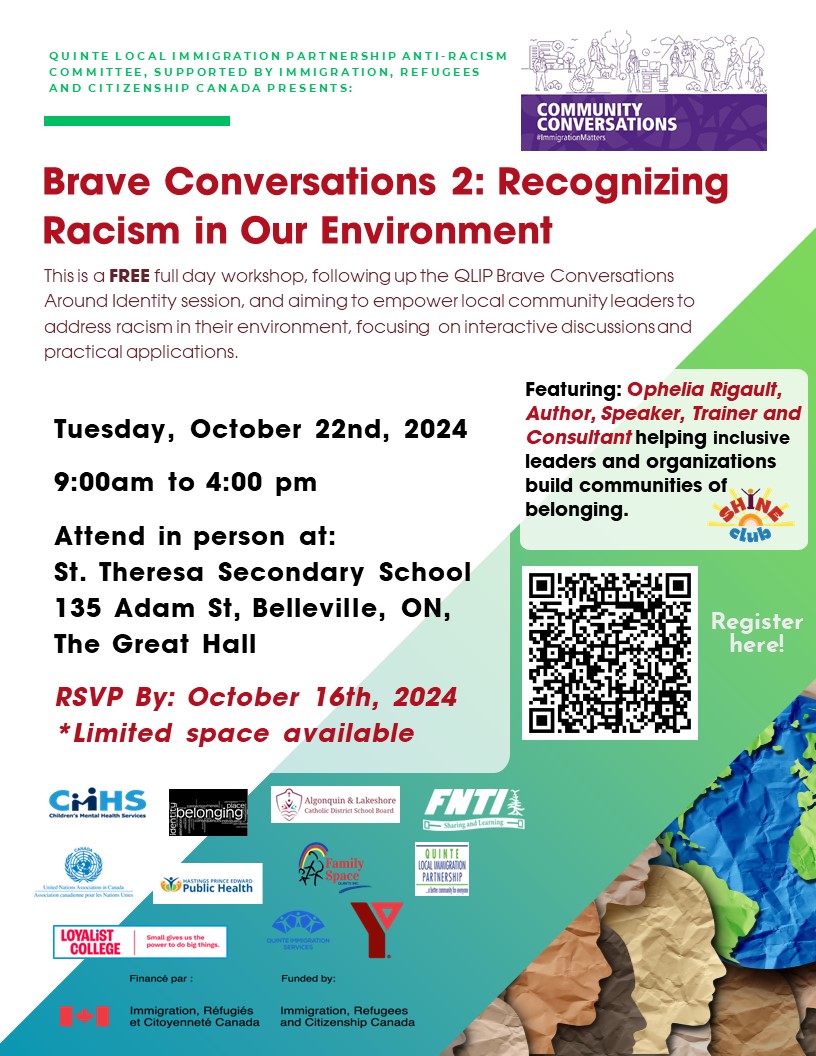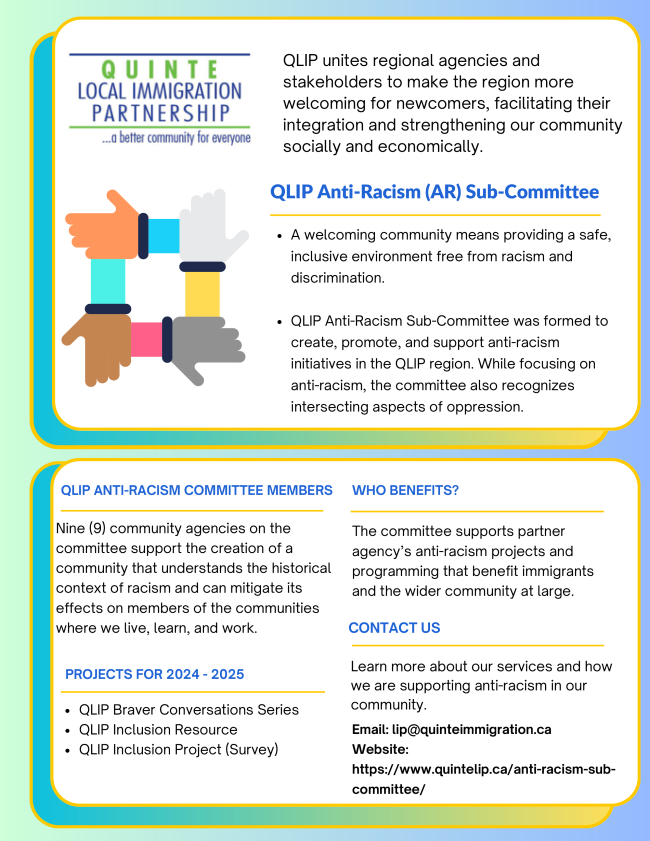QLIP Anti-Racism Sub-Committee
Established in 2021, the QLIP Anti-racism Sub-committee is the only Anti-racism group of its kind in the Quinte region.
Purpose
Made up of QLIP member agencies, the committee works together to create, promote and support anti-racism initiatives in the geographic region supported by the Quinte Local Immigration Partnership (QLIP). The primary focus of the committee is on anti-racism, while recognizing intersecting aspects of oppression.
Vision
To support the creation of a community that understands the historical context of racism and has the knowledge and skills to reduce and mitigate the effects of racism on members of the communities where we live, learn and work.
Purpose
The purpose of the committee is to work together as member agencies to create, promote and support anti-racism initiatives in the geographic region supported by the Quinte Local Immigration Partnership (QLIP). The primary focus of the committee will be on anti-racism, while recognizing that intersecting aspects of oppression exist and should be considered in our overall focus. For example, a person who identifies as a transgender Black woman, may have a compounded experience of discrimination compared to a cisgender Black woman.
Vision
To support the creation of a community that understands the historical context of racism and has the knowledge and skills to reduce and mitigate the effects of racism on members of the communities in where we live, learn and work.
Responsibilities
Provide information and education regarding racism in the community to members of the Quinte Local Immigration Partnership and the community at large.
- Amplify existing anti-racism education in the community that are in alignment with QLIP anti-racism committee core values [e.g., All Welcome Here, MBQ- Education Officer, United Nations Association of Quinte].
- Support the collaborative efforts of community agencies and the community at large to recognize and address prejudice, stigma, discrimination, and oppression through a cultural humility (1) lens.
- Engage in reflective practice.
Geographic region
Hastings, Prince Edward, and parts of Northumberland and Lennox and Addington counties who are serviced by QLIP.
Accountability
Responsible to QLIP Members and will report on sub-committee progress at QLIP meetings. All members are expected to review, understand and agree upon common definitions in Appendix A. These definitions will be reviewed for relevance on a regular basis.
Meetings (9) ensure there is racialized and Indigenous representation on the committee (minimum 30%)
- Chair– Victoria Law, SDOH Public Health Nurse, Hastings Prince Edward Public Health
- QLIP coordinator/Co-Chair – Cat Fisher Andrews QLIP/QUIS
i)Cultural humility is a lifelong commitment to self-evaluation and critique, to redressing power imbalances . . . and to developing mutually beneficial and non-paternalistic partnerships with communities on behalf of individuals and defined population. (Greene-Moton & Minkler)
Indigenous work is sovereignty based and not equity based.
Version January 2024
3. Member- Julie Muli, HR Manager, Children’s Mental Health Services
4. Member- Aruna Alexander, President, United Nations Association Quinte
5. Member Nikki Auten, First Nations Technical Institute
6. Member-Trecia McLennon, Director of Equity Diversity and Inclusion, Loyalist College
7. Member- Jessica Lindsay-Sonkin, Educator, All Welcome Here
8. Member – Darcey French, Superintendent of Education, Algonquin Lakeshore District School Board
9. Member – Chantelle Edwards, Network Coordinator, The Students Commission of Canada
10. Member- Carrie Oswald, Inclusive Leader, Belonging Redefined
Meetings
- The frequency of meetings will be every month for a duration of 60-120 minutes.
- The committee members will decide upon the days and times of the meeting and will be revisited as needed to meet member schedules.
Recommendations and Decision Making
- If the Chair is unable to attend, the Co-Chair will lead.
- Organizations or representatives can send an alternate if they have reviewed the TOR and related definitions.
- The meeting can move forward with 30% of members in attendance.
- Decision making should be held out until 60% of members are in attendance.
- If a member has not been present for more than three meetings, the chair shall reach out to the member and determine if the member would like to continue to be a part of the committee. It is expected they will attend the next meeting to confirm their membership. Otherwise, their resignation will be implied.
Agenda
- The agenda will be developed by the Chair and Co-Chair and will be distributed at least one business day before the upcoming meeting.
- The Committee will discuss the agenda items for the next meeting at the end of each meeting.
- Agenda items can be added by committee members by notifying the Chair/Co-Chair no later than two business days before the next meeting.
Membership
- Members shall include members of the QLIP as well as open to individuals requesting membership to the committee via approval of current members.
- Preference will be given to racialized community members, newcomers, and people with lived/living experience.
- M embership shall be capped at twelve.
Communication Plan
- • Meeting minutes will be circulated from the prior month’s meeting with the agenda
- • Historical agendas, minutes, resources shall be made available to committee members via contacting the Chair/Co-Chair
- • The Chair will make verbal reports of the committee’s progress at meetings
- • The Chair/Co-Chair will communicate updates via email and/or at all meetings.
- • Documents created by the committee and any other information will be available to members via email and stored by the co-chair
- • Members are invited to provide feedback to chair/co-chairs at any time to improve meetings and ensure a safe space for all members
Appendix A: Terms to Build a Common Understanding based on Ontario Health (Ontario Health, 2022)’s Equity, Inclusion, Diversity and Anti-Racism Framework (Ontario Health, 2022)
Anti-Racism: An anti-racism approach is a systematic method of analysis and a proactive course of action. The approach recognizes the existence of racism, including systemic racism, and actively seeks to identify, reduce and remove the racially inequitable outcomes and power imbalances between groups and the structures that sustain these inequities.
Anti-Black Racism: The policies and practices rooted in Canadian institutions such as education, healthcare, and justice that mirror and reinforce beliefs, attitudes, prejudices, stereotyping and/or discrimination towards Black people and communities
Anti-Indigenous Racism: Anti-Indigenous racism is the ongoing race-based discrimination,
negative stereotyping, and injustice experienced by Indigenous Peoples within Canada. It includes ideas and practices that establish, maintain and perpetuate power imbalances, systemic barriers, and
inequitable outcomes that stem from the legacy of colonial policies and practices in Canada.
Diversity: The range of visible and invisible qualities, experiences and identities that shape who we are, how we think, how we engage with and how we are perceived by the world. These can be along the dimensions of race, ethnicity, gender, gender identity, sexual orientation, socioeconomic status, age, physical or mental abilities, religious or spiritual beliefs, or political ideologies. They can also include differences such as personality, style, capabilities, and thought or perspectives.
Equity: Unlike the notion of equality, equity is not about sameness of treatment. It denotes fairness and justice in process and in results. Equitable outcomes often require differential treatment and resource redistribution to achieve a level playing field among all individuals and communities. This requires recognizing and addressing barriers to opportunities for all to thrive in our society
Inclusion: Inclusion recognizes, welcomes and makes space for diversity. An inclusive organization capitalizes on the diversity of thought, experiences, skills and talents of all employees
Intersectionality: The ways in which our identities (such as race, gender, class, ability, etc.) intersect to create overlapping and interdependent systems of discrimination or disadvantage. The term was coined by Black feminist legal scholar Dr. Kimberlé Crenshaw and emerged from critical race theory to understand the limitations of “single-issue analysis” in regards to how the law considers both sexism and racism. Intersectionality today is used more broadly to understand the impact of multiple identities to create even greater disadvantage.
Structural racism: Is a system in which public policies, institutional practices, cultural representations, and other norms work in ways to reinforce and perpetuate racial group inequity. It identifies dimensions of our history and culture that have allowed white privilege and disadvantages associated with colour to endure and adapt over time. Structural racism is not something that a few people or institutions choose to practice. Instead, it has been a feature of the social, economic and political systems in which we all exist
Systemic Racism: Organizational culture, policies, directives, practices or procedures that exclude, displace or marginalize some racialized groups or create unfair barriers for them to access valuable benefits and opportunities. This is often the result of institutional biases in organizational culture, policies, directives, practices, and procedures that may appear neutral but have the effect of privileging some groups and disadvantaging others.
Racialized: This term describes people marginalized by the forces of racism. “The word “racialized” stresses the fact that race is neither biological nor objective but is a concept which is societal in origin.” (Takwa, Souissi; Ma, Clayton, 2022).
References
Greene-Moton, E., & Minkler, M. (n.d.). 1. . (2020). Cultural competence or cultural humility? Moving beyond the debate. Health promotion practice, 21(1), 142-145.
Ontario Health. (2022). Building a Common Understanding. Retrieved from Equity, inclusion, diversity and anti-racism: https://www.ontariohealth.ca/sites/ontariohealth/files/2020-12/Equity%20Framework.pdf
Contact Information
QLIP STAFF



